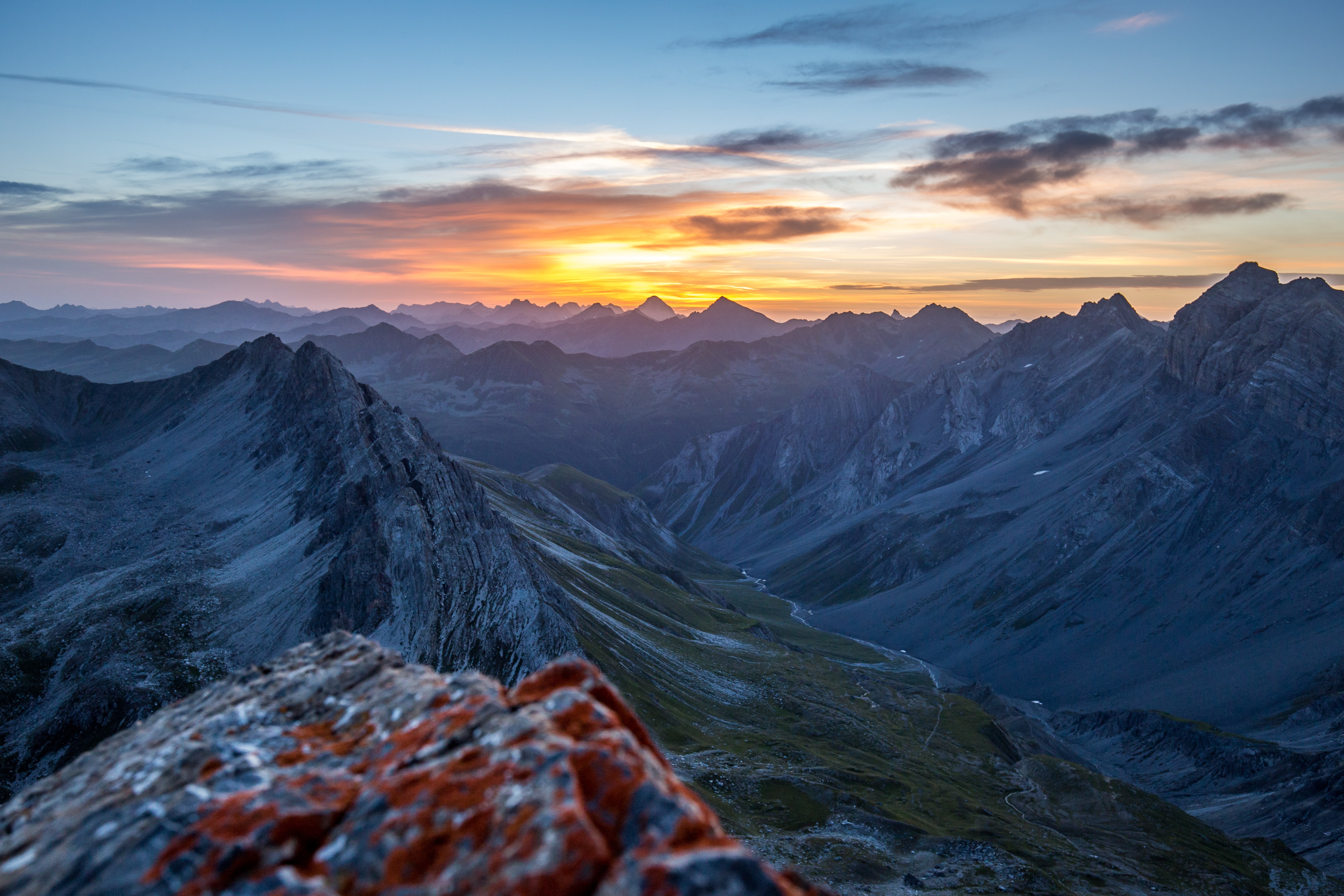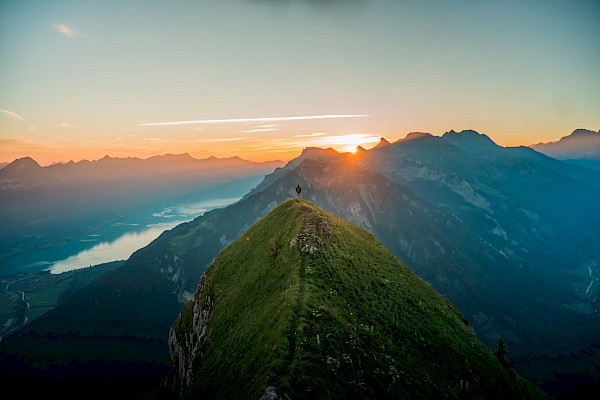Hiking in the mountains is not going for a walk
We went hiking in the mountains and felt all of Switzerland with us. People are flocking to the mountains, particularly this summer, when so many of us are spending our summer holiday in our own country. Whether by bike or on your own two feet, we all enjoy the Swiss mountain landscape.
Hiking is one of the most popular sports in Switzerland. 57% of the Swiss population and a great many tourists make use of Swiss hiking trails over the year, and the trend is rising. Unfortunately, many of them choose routes that are too demanding, which time and again results in serious accidents. Every year, 40 Swiss people die when hiking in the mountains, and another 4000 are seriously injured – most of them in falls.
Hiking in the mountains is not going for a walk. To go hiking in the Swiss mountains, you should be sure-footed and not suffer from vertigo, as well as having a certain basic level of fitness. Otherwise, your trip into the mountains could get dangerous.
We don’t want to frighten you with these statements, but rather give you useful tricks and tips for mountain hiking – see also our Wanderlust series, starting in August. Ultimately, you should be able to enjoy your trip to the mountains, the hiking and your time in the open air, and come home safe and sound at the end of the day.
“Hiking is an activity of the legs and a state of the soul.”
(Josef Hofmiller)
Good planning is half the battle
Enjoying nature, picnicking, chatting and laughing. Idyllic pictures of hiking in the mountains are certainly justified, but although it looks easy-going, it may not be easy. Unlike walking, hiking follows a fine line between comfort and challenge. Mountain hiking is demanding, and careful planning is indispensable.
Planning your route
You and your companions will benefit from careful planning and preparation, right up to returning home afterwards, and for every future hike too. Hiking guidebooks, up-to-date maps and websites are good aids for preparation and orientation. For every hike, you should absolutely respect the following factors:
- The hike’s starting point, route and destination
- Distance and altitude: the latter is frequently the sticking point in (mountain) hikes. Always be aware that the ascent requires time and strength, and the descent demands coordination and is hard on your knees in the long run.
- The time required plus a buffer: the times given on websites and in hiking guidebooks are approximate averages without breaks. Planning sufficient time for breaks and unforeseeable events is recommended. Particularly when hiking with children, older people and people with disabilities, it is worth calculating an extra buffer.
- Alternatives: check out alternative routes in advance, to avoid more difficult stretches and to shorten the route if you get tired or the weather changes.
- Travelling there and back: find out in advance when the first post bus goes up the valley and the last cable car goes down. Check the weather conditions and find out what time the sun sets. Particularly for long hikes at high altitude, you should start as early as possible, so you can reach your destination before nightfall.
- Alpine huts: would you like to spend the night in an alpine hut or enjoy a meal in a mountain restaurant? Check the exact location of the hut/mountain restaurant in advance, and whether it is serviced or open. Remember that reserving a place to sleep is a must. If you change your plans at short notice, and give up the idea of overnighting on the mountain, do your fellow mountaineers a favour and cancel your reservation.
You can find a mountain hiking checklist here here.
Your route, the weather and you
- Physical constitution and abilities: are you currently feeling physically fit and sure-footed, and not suffering from vertigo? Have you been hiking before, or is this your first hike this year? Have you recently been ill or are you currently very stressed? If you are hiking with other people, then ask yourself which route will be fair to the technically and constitutionally weakest member of the group.
- Hiking route categories: does your hike follow a mountain route, an alpine route or a hiking trail? Each of these three categories will give you different challenges.
- Route conditions: has it rained in the last few days? Routes can remain wet and slippery in places for several days. Such conditions make exposed areas particularly dangerous. Remember that snow can still lie at mid altitudes in many places on the Swiss mountains even in early summer. You can find out about the current conditions on the ground at the cable car stations, via webcams and on hiking portals, as well as obtaining information from hut wardens.
- Other requirements: find out in advance about factors such as steep stretches, height above sea level, exposed places, elevation profiles, etc.
- Local weather forecasts: when hiking in the mountains, checking the weather on the mountain and how it develops is of the utmost importance. Sunny weather in the valley does not mean sunny weather on the mountain. Use a suitable website like Meteo Schweiz, the SRF Meteo weather radar or specific weather apps.
- Risk of storms: Bei einem Gewitter solltest du möglichst nicht auf freiem Gelände in den Bergen unterwegs sein. Prüif there is a storm, you should, if possible, not move across open ground in the mountains. Check the region’s storm risk in advance. If a storm is highly likely, you should postpone your hike or at most take a short hike around the valley.
Meanwhile, here is a mini quiz:
How well do you know the signposts in the Swiss mountains? Test your knowledge! Only 1 answer is correct for each question.
- Hiking trails in Switzerland are marked by:
a) Red-white-red signposts, arrows
b) Yellow signposts, rhombi and arrows
c) Yellow signposts with white-red-white tips
- Alpine routes are indicated by:
a) White-blue-white markings and blue signposts with white-blue-white tips
b) Yellow signposts, rhombi and arrows
c) White-red-white markings and yellow signposts with white-red-white tips
- Mountain routes are indicated by:
a) Yellow signposts with white-red-white tips and white-red-white markings
b) Yellow signposts, rhombi and arrows
c) Blue signposts with white-blue-white tips and white-blue-white markings
You will find the answers at the end of this article.
Tell someone where you’ll be and what route you’re taking
- Imagine you have an emergency and need help, but nobody knows where you are. That would literally be crap. Not just for you, but also for everyone who would need to search for you after a certain time. Make sure you tell friends, acquaintances or family members about your route and destination and how long it will take – even if you’re hiking with one or several other people.
- Remember to get in touch with them after you get home from your hike. Your contact person will be pleased and relieved to hear from you.
- When mountain hiking, the axiom is: never take difficult or remote trails alone!
All in good time
Most hike times are calculated with special software and as such are averages. The software is certainly reliable; however, every person is individual. Consequently, some will need rather longer, and others won’t need that much. With some hiking experience, you will know whether you are faster or slower than average in completing a route. Of course, how many breaks you take, and how long for, also plays a part here.
You can calculate your hike time (without breaks) using the following rule of thumb:
- Ascent: 15 minutes for every 100 metres of ascent plus 15 minutes for every kilometre of horizontal distance.
- Descent: 15 minutes for every 200 metres of descent plus 15 minutes for every kilometre of horizontal distance.
How fit, sure-footed and free of vertigo are you?
Overconfidence is a big problem in hiking in Switzerland. Many people underestimate the routes and/or overestimate their abilities and the physical conditions. A certain basic level of fitness, sure-footedness and lack of vertigo is absolutely necessary for mountain hiking. Test yourself and find out whether you are ready for your next mountain hike. You can find the self-test here.
Are you not so sure-footed and need a little more practice? No problem. Regular strength and balance training will improve your sure-footedness, coordination and condition, and prepare you for your next hike in the best possible way. You can find suitable exercises and good tips for building the training easily into your daily routine at sichergehen.ch.
Well-equipped: “as little as possible – as much as necessary”
Being well-equipped for hiking begins with your feet and ends at your head. You can find everything you need to know about hiking equipment, from hiking boots through rucksacks and clothing to maps and emergency materials on the website sicher-bergwandern.ch (https://sicher-bergwandern.ch/de/gut-ausgeruestet) or from the BFU (https://www.bfu.ch/de/dossiers/wandern-und-bergsport).
We look forward to introducing you to our favourite hiking trails in the near future. Our “Wanderlust” series of articles starts in August – worth making a note of! Did you enjoy this article? Then you might also like our article “Hiking in Zug Canton: favourite hiking routes from the Amt für Sport».
Further information and links:
- BFU – Ratgeber «Wandern in den Bergen – Sicher über Stock und Stein»
- BFU – Ratgeber «Bergsteigen – Tipps für mehr Sicherheit»
- BFU – Ratgeber «Schutz vor Blitzschlag – Rechtzeitig reagieren»
- BFU – Ratgeber «GPS für den Sport – Helfer für die Orientierung»
- BFU – Ratgeber «Klettersteig gehen – Sicher über dem Abgrund»
- Flyer «Kuhmütter schützen ihre Kälber – halten Sie Distanz!»
- Packing list
- Schwierigkeitsskala von SchweizMobil
- Schwierigkeitsskala «SAC- Berg- und Alpinwanderskala»
- Swisstopo – digital maps
- SchweizMobil - digital maps
- SWW Swiss hiking trails
- SchweizMobil Swiss hiking trails
- Rega-App (iOs / Android) - Alarmierung im Notfall
Mini-quiz answers: Correct answers: 1b) / 2a) / 3a)
 subscribe to newsletter
subscribe to newsletter


